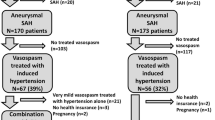Abstract
Intrathecal nicardipine has been shown to have some efficacy for the treatment of symptomatic cerebral vasospasm in aneurysmal subarachnoid hemorrhage (aSAH). We performed a PRISMA-based systematic review of intrathecal nicardipine for the treatment of cerebral vasospasm in aneurysmal subarachnoid hemorrhage. A total of 825 articles were reviewed. After duplicates were removed and the search criteria was applied, 9 articles remained that were eligible for inclusion and analysis. 377 patients received a total of 6,596 injections of intrathecal nicardipine for aSAH-related cerebral vasospasm. The cumulative ventriculostomy-associated infection risk was 6%. Intrathecal nicardipine injections for aSAH-related cerebral vasospasm appears efficacious and safe. Administration of 4 mg of nicardipine every 12 hours was the most commonly reported dosing regimen. Intrathecal nicardipine decreases mean flow velocities on transcranial Doppler and reduces angiographic and clinical vasospasm. The infection risk appears to be in-line with studies in which rates of EVD-related infections have been reported.

Similar content being viewed by others
References
Connolly ES, Rabinstein AA, Carhuapoma JR, Derdeyn CP, Dion J, Higashida RT, et al. Guidelines for the management of aneurysmal subarachnoid hemorrhage: a guideline for healthcare professionals from the American Heart Association/American Stroke Association. Stroke. 2012;43(6):1711–37.
Al-Khindi T, Macdonald RL, Schweizer TA. Cognitive and functional outcome after aneurysmal subarachnoid hemorrhage. Stroke. 2010;41(8):e519–36.
Velat GJ, Kimball MM, Mocco J, Hoh BL. Vasospasm after aneurysmal subarachnoid hemorrhage: review of randomized controlled trials and meta-analyses in the literature. World Neurosurg. 2011;76(5):446–54.
Petruk KC, West M, Mohr G, Weir BK, Benoit BG, Gentili F, et al. Nimodipine treatment in poor-grade aneurysm patients: results of a multicenter double-blind placebo-controlled trial. J Neurosurg. 1988;68(4):505–17.
Fujiwara K, Mikawa S, Ebina T. Continuous intrathecal administration of nicardipine using a portable infusion pump system for management of vasospasm after subarachnoid hemorrhage. No shinkei geka Neurol Surg. 2001;29(1):23–30.
Haley EC Jr, Kassell NF, Torner JC. Participants: a randomized controlled trial of high-dose intravenous nicardipine in aneurysmal subarachnoid hemorrhage: a report of the Cooperative Aneurysm Study. J Neurosurg. 1993;78(4):537–47.
Ko S-B, Choi HA, Helbok R, Kurtz P, Schmidt JM, Badjatia N, et al. Acute effects of intraventricular nicardipine on cerebral hemodynamics: a preliminary finding. Clin Neurol Neurosurg. 2016;144:48–52.
Lu N, Jackson D, Luke S, Festic E, Hanel RA, Freeman WD. Intraventricular nicardipine for aneurysmal subarachnoid hemorrhage related vasospasm: assessment of 90 days outcome. Neurocrit Care. 2012;16(3):368–75.
Ehtisham A, Taylor S, Bayless L, Samuels OB, Klein MW, Janzen JM. Use of intrathecal nicardipine for aneurysmal subarachnoid hemorrhage-induced cerebral vasospasm. South Med J. 2009;102(2):150–3.
Goodson K, Lapointe M, Monroe T, Chalela JA. Intraventricular nicardipine for refractory cerebral vasospasm after subarachnoid hemorrhage. Neurocrit Care. 2008;8(2):247–52.
Webb A, Kolenda J, Martin K, Wright W, Samuels O. The effect of intraventricular administration of nicardipine on mean cerebral blood flow velocity measured by transcranial Doppler in the treatment of vasospasm following aneurysmal subarachnoid hemorrhage. Neurocrit Care. 2010;12(2):159–64.
Suzuki M, Doi M, Otawara Y, Ogasawara K, Ogawa A. Intrathecal administration of nicardipine hydrochloride to prevent vasospasm in patients with subarachnoid hemorrhage. Neurosurg Rev. 2001;24(4–6):180–4.
Shibuya M, Suzuki Y, Enomoto H, Okada T, Ogura K, Sugita K. Effects of prophylactic intrathecal administrations of nicardipine on vasospasm in patients with severe aneurysmal subarachnoid haemorrhage. Acta Neurochir. 1994;131(1–2):19–25.
Toyota A, Nishizawa Y. Cerebral vasospasm after subarachnoid hemorrhage, and inhibitory effect of nicardipine investigated by means of transcranial Doppler ultrasonography. No shinkei geka Neurol Surg. 1991;19(12):1143–50.
Yamamoto M, Ohta T, Toda N. Mechanisms of relaxant action of nicardipine, a new Ca ++-antagonist, on isolated dog cerebral and mesenteric arteries. Stroke. 1983;14(2):270–5.
Pasqualin A, Vollmer DG, Marron JA, Tsukahara T, Kassell NF, Torner JC. The effect of nicardipine on vasospasm in rabbit basilar artery after subarachnoid hemorrhage. Neurosurgery. 1991;29(2):183–8.
Williams TA, Leslie GD, Dobb GJ, Roberts B, van Heerden PV. Decrease in proven ventriculitis by reducing the frequency of cerebrospinal fluid sampling from extraventricular drains. J Neurosurg. 2011;115(5):1040–6.
Inoue T, Shimizu H, Fujimura M, Sato K, Endo H, Niizuma K, et al. Risk factors for meningitis after craniotomy in patients with subarachnoid hemorrhage due to anterior circulation aneurysms rupture. Clin Neurol Neurosurg. 2015;139:302–6.
Lozier AP, Sciacca RR, Romagnoli MF, Connolly ES Jr. Ventriculostomy-related infections: a critical review of the literature. Neurosurgery. 2002;51(1):170–82.
Hanley DF, Lane K, McBee N, Ziai W, Tuhrim S, Lees KR, et al. Thrombolytic removal of intraventricular haemorrhage in treatment of severe stroke: results of the randomised, multicentre, multiregion, placebo-controlled CLEAR III trial. The Lancet. 2017;389(10069):603–11.
Edge therapeutics provides update following interim analysis of phase 3 NEWTON 2 study of EG-1962 in aneurysmal subarachnoid hemorrhage. GlobeNewswire. 28 March 2018.
Funding
The authors received no support for this contribution.
Author information
Authors and Affiliations
Contributions
SH and RG contributed equally to the design of the study. SH performed the preliminary data analysis with confirmation by RG. SH and RG equally contributed to the analysis of the results and writing of the manuscript.
Corresponding author
Ethics declarations
Conflict of interest
The authors declare that they have no conflict of interest.
Electronic supplementary material
Below is the link to the electronic supplementary material.
Rights and permissions
About this article
Cite this article
Hafeez, S., Grandhi, R. Systematic Review of Intrathecal Nicardipine for the Treatment of Cerebral Vasospasm in Aneurysmal Subarachnoid Hemorrhage. Neurocrit Care 31, 399–405 (2019). https://doi.org/10.1007/s12028-018-0659-9
Published:
Issue Date:
DOI: https://doi.org/10.1007/s12028-018-0659-9




